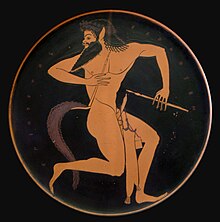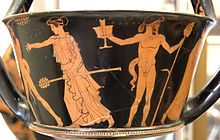Satyr
A Satyr ( ancient Greek Σάτυρος Satyros , plural Σάτυροι Sátyroi , latin Satur, Saturus ) or Silen ( Σιληνός, Σειληνός Silenus, Silenus , plural Σιληνοί, Σειληνοί Silēnói, Seilēnói , dorisch Σιλανός Silanos , latin Silenus, Silanus ) is in the Greek mythology a demon in the wake of Dionysus . Satyrs belong to the hybrid creatures of Greek mythology. They appear relatively late at the end of the 7th century BC. Chr. On; as a single figure, Silenus stands out above all . A distinction is made between the Silene ( Silenoi , older satyrs with fat bellies and bald heads) and satyrisks ( Satyriskoi , juvenile and childish satyrs), although it is often not possible to distinguish clearly in the visual representation. They are identified with the faunas by Roman poets .
myth
Nothing is known precisely about the origin of the satyrs; According to Hesiod , they are said to be descended from five daughters of Hekaterus . They represented the male principle towards the nymphs . As similar nature spirits, they carried attributes of the “all-god” Pan as well as some of Priapus . Her name meant in a dialect of the old Peloponnese "the full one", which related to both her physique and the erotically excited state.
The satyrs and Silene are said to have fought as a troop of Dionysus in the gigantomachy and with the screaming of their donkeys put the giants in fear and terror.
Otherwise there is little to be found in Greek mythology about satyrs as a whole, very little compared to their presence in art, especially vase painting. Something can be found in relation to individual satyrs, for example in the Dionysiacs , the great epic of the Nonnos of Panopolis about the myths about Dionysus , especially his campaign to India, several satyrs are mentioned by name, but these remain largely contourless and their names are mostly derived from epithets of Dionysus.
Satyrs associated with their own myths:
- Ampelus , Dionysus's lover, was killed by a bull and turned into a vine by Dionysus;
- Krotos , inventor of the bow and clock in the song of the muses, was moved to the sky as the constellation Sagittarius ;
- Marsyas , who lost a musical competition with Apollon , was beaten by the living god for it .
- Silenus , leader of the choir of satyrs and Silenians in the satyr play, educator of Dionysus.
presentation

Mostly the satyrs or Silenians are shown snub-nosed, bald, undressed and ithyphallic . As hybrid creatures, they are usually equipped with the ears and tails of horses or donkeys, and often with animal extremities. Their pictorial representation begins in the 6th century BC. In the vase painting of Attica , Crete and Thasos , a gargoyle in the shape of a head comes from the temple of Apollo in Thermos from this time. As a retinue of Dionysus they are often represented with the maenads, who also belong to the Dionysian retinue .
In representations of the archaic they are equipped with horse or donkey features and are only shown in connection with a few mythological motifs, with the development of the satyr game they then appear increasingly in other contexts. Also under the influence of the satyr plays they appear increasingly anthropomorphic as the inventor of viticulture and music and as a bearer of culture, but always remain beastly enough to a counterpart to the values of the polis citizens to represent or to the mythical exaggeration of the Symposium and Komos to serve . Their typical attributes are attached to them at an early stage. Already on the François Vase is enclosed with Askos they associated with the wine, with both the cultivation and with the pleasure of Aulos with music and dance. In Attic representations, they are mostly snub-nosed participants in a como with human feet or they lasciviously approach the maenads, whereby sexual acts rarely occur.
They received their goat characteristics only in Hellenism , probably under the influence of representations of the Panen and the Paniskoi , who appeared in the same role as the satyrs. They appear now with the goblet, now in a Bacchic frenzy with the thyrsus , now devoted to sleep, now pressing, also playing the flute or beating the cymbal , often also united with the nymphs in quick dances or lustfully pursued them.
Praxiteles is considered to be the creator of the sculpture of resting satyrs .
Mosaic from the House of the Faun , Pompeii
Adolescent satyr with flute, Louvre
Satyr with nymphs, William Adolphe Bouguereau , 1873
Sicilian boy as a faun, Wilhelm von Gloeden , 1898
See also
literature
- Christiane Ackermann: Silenus, satyr. In: Maria Moog-Grünewald (Ed.): Mythenrezeption. The ancient mythology in literature, music and art from the beginnings to the present (= Der Neue Pauly . Supplements. Volume 5). Metzler, Stuttgart / Weimar 2008, ISBN 978-3-476-02032-1 , pp. 647-654.
- Balbina Bäbler: Satyr. In: The New Pauly (DNP). Volume 11, Metzler, Stuttgart 2001, ISBN 3-476-01481-9 , Sp. 119-122.
- Frank Brommer : σιληνοί and σάτυροι . In: Philologus . Volume 94, 1941, pp. 222-228.
- Peter Gercke: Satyrs of Praxiteles. Dissertation Hamburg 1968
- Guy Michael Hedreen: Silens in Attic Black-figure Vase-painting: Myth and Performance. University of Michigan Press, 1992.
- Ernst Kuhnert : Satyros and Silenos . In: Wilhelm Heinrich Roscher (Hrsg.): Detailed lexicon of Greek and Roman mythology . Volume 4, Leipzig 1915, Col. 444-531 ( digitized version ).
- François Lissarrague: Les satyres et le monde animal. In: J. Christiansen, T. Melander (Eds.): Proceedings of the Third Symposium on Ancient Greek and related Pottery. Copenhagen 1988, pp. 335-351.
- Erika Simon : Silenoi . In: Lexicon Iconographicum Mythologiae Classicae (LIMC). Volume VIII, Zurich / Munich 1997, pp. 1108–1133.
- Adrian Stähli : The denial of lust. Erotic groups in ancient plastic. Reimer, Berlin 1999, ISBN 3-496-01195-5 .
Web links
- Satyrs in the Theoi Project (English)
Individual evidence
- ↑ Hesiod in Strabo 10: 3, 19 p. 471
- ↑ Karl Kerényi: The mythology of the Greeks. Volume 1. 1984, ISBN 3-423-01345-1 , p. 142
- ^ Hyginus Mythographus , Astronomica 2.23.
- ^ François Lissarrague: On the Wildness of Satyrs . In: Christopher A. Faraone , Thomas H. Carpenter (eds.): Masks of Dionysus. Cornell University Press, 1993, pp. 207-220.







